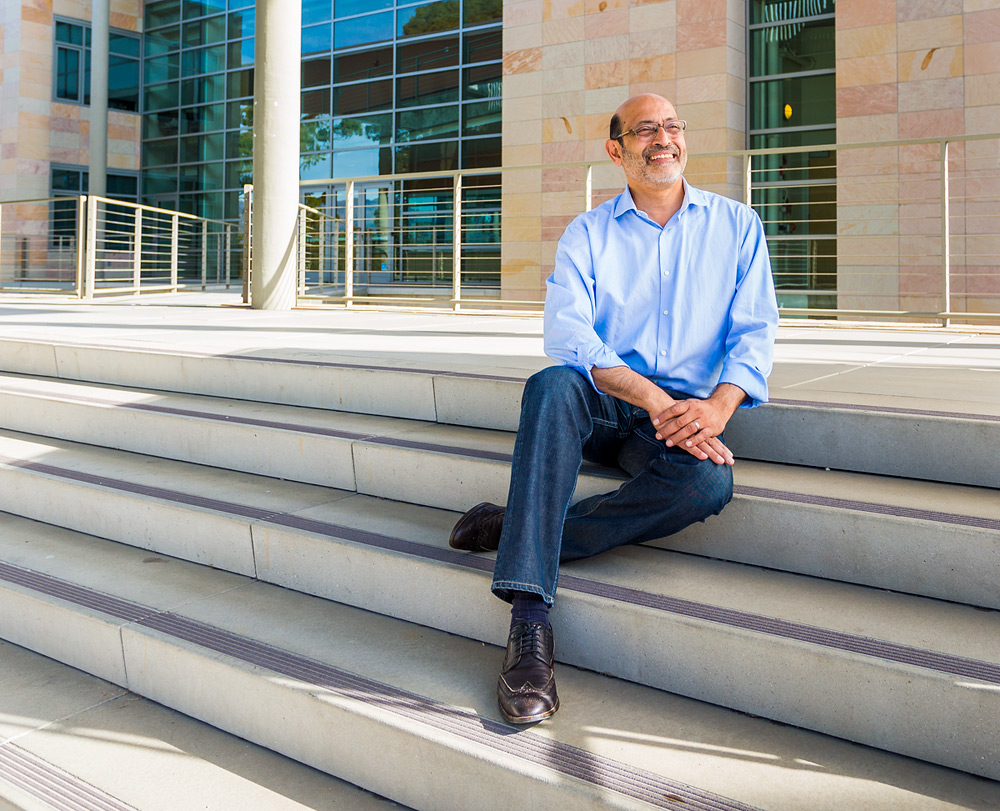
The Next Big Challenge
As we hurtle into a future dominated by the Internet of Things, in which countless devices streamline our lives while producing a prodigious amount of data every second, one thing is clear: Our growing number of machines, gadgets and appliances will need to become far more energy-efficient not just to perform their functions, but also to manipulate that deluge of data.
In addition, our power grids will need to become smarter to respond to the variable needs of the expanding population even as the world works to reduce its reliance on greenhouse gas-producing fossil fuels. Whereas speed — faster computers, high-speed data to your phone — continues to drive innovation, higher energy efficiency or reduced waste is now equally, if not more, important.
Fortunately, the world’s increasing energy needs have been anticipated by forward-looking thinkers, among them Umesh Mishra, UC Santa Barbara professor of electrical and computer engineering. Regarded by his peers in academia and in industry as a world expert in wide-bandgap materials, particularly gallium nitride (GaN), Mishra took what was a promising yet notoriously difficult material to work with and turned it into a cornerstone of energy-efficient power electronics, from efficient microwave power transmitters to energy conversion.
In recognition of his considerable contributions in the research and development of energy-efficient microwave and energy conversion power electronics, which have resulted in a market valued in the hundreds of millions of dollars as well as added to a thriving green industry, Mishra has been selected as UCSB’s 2018 Faculty Research Lecturer. It is the highest honor bestowed upon UCSB professors by their peers and recognizes extraordinary scholarly distinction.
“The understanding of the Earth’s limited resources and human impact on the planet is changing the world, where the efficiency of electronic devices is being valued alongside performance,” Mishra said. “This enables us to be lucky to witness our Sputnik moment: The challenge of widespread deployment of energy-efficient electronics impacting a broad range of applications, from efficient microwave transmission to long-range electric cars. I feel very fortunate to be able to contribute to this endeavor in a meaningful manner and, most importantly, have fun doing it with outstanding colleagues at UCSB.”
Today, much of the technology at the core our booming green industry, such as solar panels and electric vehicles, and essential yet energy-hungry tech such as data servers and cellular networks, are turning to high-performance, high-efficiency GaN. GaN has the ability to reduce the energy wasted in the conversion from power grid to appliance by as much as 50 percent, making it an ideal material for emerging and future power electronics.
Titled “Thank God for GaN,” Mishra’s Faculty Research Lecture will discuss the amplified impacts of saving energy, from reducing the need for generation to reducing the need to manage generated heat and its associated costs and impact on the design of compact things. He will deliver the lecture at a time and place to be announced later this year.
Mishra, the Donald W. Whittier Professor in Electrical Engineering, joined the UCSB faculty in 1990. He received his Ph.D. in electrical engineering from Cornell University and is an author of more than 800 publications, with more than 44,000 citations. In addition to his research and teaching, Mishra is a founder of two technology companies, Nitres and Transphorm, the former acquired by energy-efficient lighting technology company CREE, the latter continuing to deliver high-performance GaN devices.
Known also for his clear and engaging teaching style, Mishra has provided valuable mentorship to students who have won awards for presentations and papers at prestigious conferences. A partial list of Mishra’s own awards include the Institute of Electrical and Electronics Engineers’ (IEEE) 2007 David Sarnoff Award, the 2007 International Symposium on Compound Semiconductors (ISCS) Quantum Device Award and the 2012 ISCS Heinrich Welker Award. Mishra also is an IEEE Fellow and a member of the National Academy of Engineering and the National Academy of Inventors.



